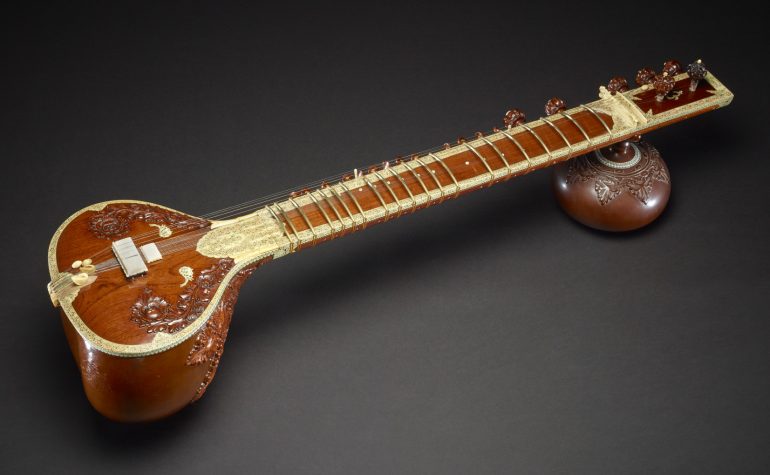Indian classical music has the power to entrance at first listen. Fresh melodic textures flow through droning tanpuras, interweaving with intricate rhythms to conjure sounds that will captivate anyone with open ears. A rāga needs no introduction to communicate deeply.
But it can be easier to absorb new music by starting from what you already know. Indian classical musicians have spent centuries exploring the fundamentals of perception, and the resulting sounds share plenty of territory with other styles. Sometimes the lineages are direct, but genres can also coincide in more surprising ways too. This article will explore these links.
We shouldn’t fall into listening to Indian music as if it were jazz, hip-hop, baroque, etc. Appreciate it directly – open your ears and let the sounds speak from themselves. But drawing links like this can be a good way to get us started – so here are a few routes to ‘listening in’ from other genres. Links to predominantly Indian music are in bold, and to save browser chaos each section has its own YouTube playlist. Scroll around – what music do you already like?
Rock
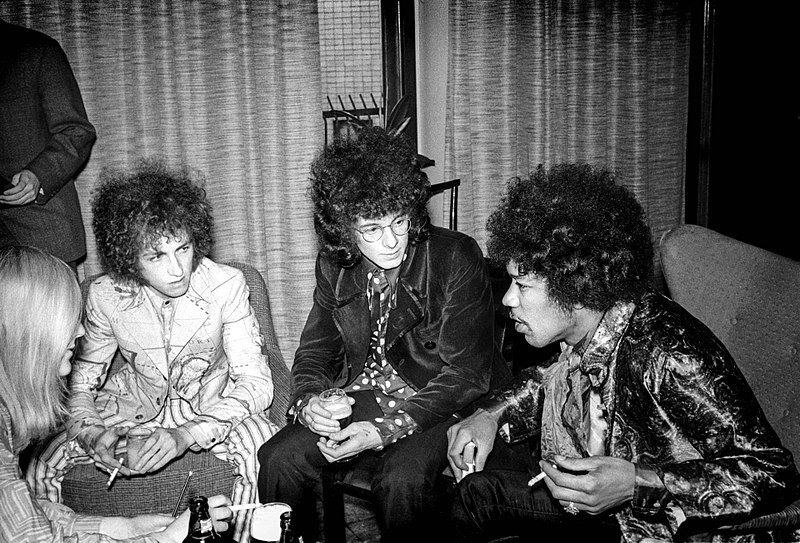
The Jimi Hendrix Experience backstage in Helsinki
At Ravi Shankar’s landmark 1967 Monterey Pop performance, Jimi Hendrix can be seen in the crowd, jaw agape. Shankar moved to California that year, mixing with rock icons and going on to play at Woodstock. He famously taught sitar to George Harrison, who used it best on Love You To and Norwegian Wood. Tanpura drones enhanced the Beatles’ later works, and by the late 60s many other rockers were turning to Indian sounds.
The Byrds’ Eight Miles High was one such psychedelic experiment. Tanpura-like drone tones open the piece, and the guitar solos are wild approximations of Indian phrases, said to have been inspired by Coltrane’s efforts in this direction. Raag Bhimpalasi draws on a similar scale pattern – here’s Niladri Kumar’s fluttering modern interpretation.
Others took the sounds in different directions, including Gabor Szabo (Jazz Rāga), Humble Pie (I’ll Go Alone), Carlos Santana (Illuminations), and Led Zeppelin (Black Mountain Side). Kula Shaker’s rāga rock is often passed off as wide-eyed gap yah antics, but they took their study seriously, singing in Sanskrit and inviting Indian musicians on stage with them (Govinda). Nowadays, Jeff Beck plays a freewheeling blend of jazz and heavy rock, impressively reworking Indian ornamentations with his Strat’s whammy bar (Nadia).
Direct influence turns up in seemingly unexpected places too – Queen’s stadium rock smuggled Indian vocal techniques to the top of the Western charts for decades. Freddie Mercury (born Farrokh Bulsara into a Parsi family) cut his teeth singing in Mumbai clubs as a teenager, and drew formative inspiration from Indian khayal singers. When asked about his vocal style, he simply replied: “I was inspired by Lata Mangeshkar”. Lata is a legendary North Indian playback singer, and Freddie clearly listened attentively to her soaring high notes – try this showreel for starters.
Rock and rāga have always intertwined with mixed results. Including Indian textures has often been seen as ‘enough’, with a lack of engagement with the underlying ideas leading to tantalisingly missed opportunities (imagine Hendrix learning the tala cycles and wah-soloing over quivering tabla breaks…). Few rockers have come close to capturing the essence directly, so perhaps it’s no surprise that you can draw clearer lines on the basis of shape and mood rather than instrumentation.
Listen to Shivkumar Sharma’s 2010 Darbar performance, with sparkling santoor hitting tabla grooves reminiscent of sped-up funk rock. Those who search for searing minor-key guitar solos will fall into Sharma’s Jod in Kaunsi Kanada, and urge the tabla to push Kala Ramnath’s calligraphic violin lines even further. And Vilayat Khan’s influential take of Rageshree hits a drut gat (fast riff) hard before wandering around the rhythm with a royal swagger.
It’s easy to see why Hendrix and other icons were enthralled. Like rock, the heights of Hindustani performance summon a direct and absolute energy, alternating powerful riffs with long instrumental solos. You can witness the musicians break through to intuitive spaces of inspiration and flow.
Convergent musical evolution can produce uncannily similar forms. Raag Jog closely matches the distinctive harmony of the famous ‘Hendrix chord’, central to Purple Haze, Voodoo Child, and other psychedelic classics. Listen to Shahid Parvez evoke Jog’s tension on the sitar, colouring rhythmic lines with joyful aggression. Rakesh Chaurasia’s solo bansuri flute version of the same rāga takes different routes to a similar enchantment.
Hendrix would surely have approved of Amjad Ali Khan’s sarod playing too. Khan blurs melody and rhythm, using wide slides to conclude the rain-bringing Malhar. Notice the two tabla drummers on stage, reminiscent of the Allman Brothers’ dual drum setup. (In fact, Whipping Post’s 11-beat intro rhythm matches the cycle length of ancient talas used to accompany kathak dance, and 11-beat patterns also turn up as the backdrop to U Srinivas’ fearsome electric mandolin soloing on Shakti’s 5 in the Morning, 6 in the Afternoon.)
Make no mistake – you can definitely headbang to Indian classical (just do it reverentially). Don’t just take my word for it – watch my guru Shivnath Mishra and his son Deobrat towards the end of a concert in Austria. Sitar jugalbandi duets can get seriously heavy…
(And in case you’re wondering, Ravi Shankar watched Hendrix’s set at Monterey too. He was impressed with the music (“fantastic…so very loud”), but horrified at witnessing Hendrix burn his guitar (“the greatest sacrilege possible”). I doubt Hendrix would have sacrificed an Indian instrument in the same way – I mean look at them – although he did experiment with the Coral Electric Sitar. Who knows what rock might sound like now had he sat alongside Harrison learning the real thing?)
Blues
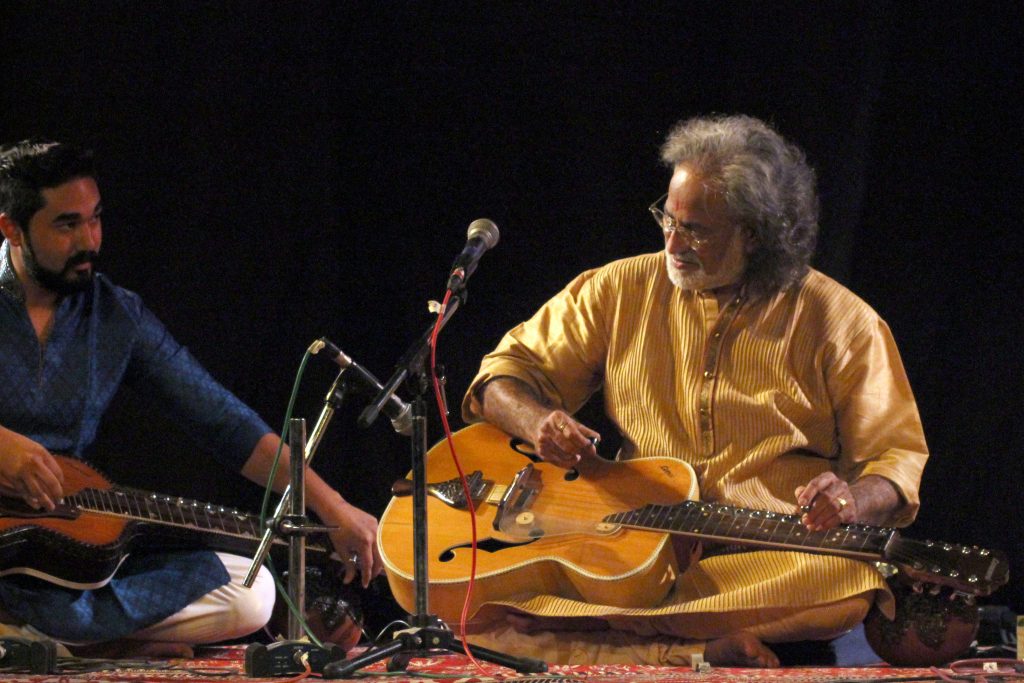
Vishwa Mohan Bhatt slides on his Mohan Veena
Great blues guitarists can captivate a crowd by bending around a single note, but even Stevie Ray Vaughan couldn’t match the sweeping ranges of Carnatic music. Jayanthi Kumaresh’s Saraswati veena is an ancient instrument, but the gently electrified version produces a strikingly guitaristic tone – hear her bend her way through the bluesy Shanmukhapriya.
All Indian classical instruments are designed to capture gayaki ang (‘singing style’), employing a breathtaking array of slides, glides, bends, and vibratos to emulate and extend the expressive flexibility of the voice. Lap-slide guitars are ideally suited, with a short scale length and crisp vocal-register tone. The Mohan veena is a 20-stringed Indo-Hawaiian hybrid – hear Vishwa Mohan Bhatt, its creator, attack Bihag’s major-key refrain.
Others have devised their own eponymous variants, including the Hansaveena and Shankar veena. Debashish Bhattacharya pushes slide’s outer limits on his self-designed ‘Trinity of Guitars’, led by the chaturangi – a 22-stringed blend of guitar, sitar, sarod, and veena.
Influence has gone the other way too – introspective bluesman Harry Manx studied with Bhatt, and has brought his inventions back West into blues songwriting. Slide virtuoso Derek Trucks brings an overdriven tone to his impressive cover of Sahib Teri Bandi, originally by Pakistan’s Qawwali superstar Nusrat Fateh Ali Khan.
Aruna Sairam’s voice brings a husky authority to modern Carnatic music. She draws inspiration from ancient myths of Shiva’s serpent battles, and pushes her tradition forward with frequent global collaborations. Earlier in 2018 she teamed up with Soumik Datta’s sarod for Bagri Foundation’s Back to the Blues, a one-off London concert combining jazz, blues Celtic, Carnatic, and Hindustani. Sairam and Datta pass familiar melodies between them, rearticulating blues vocabulary over lilting piano chords.
Jazz
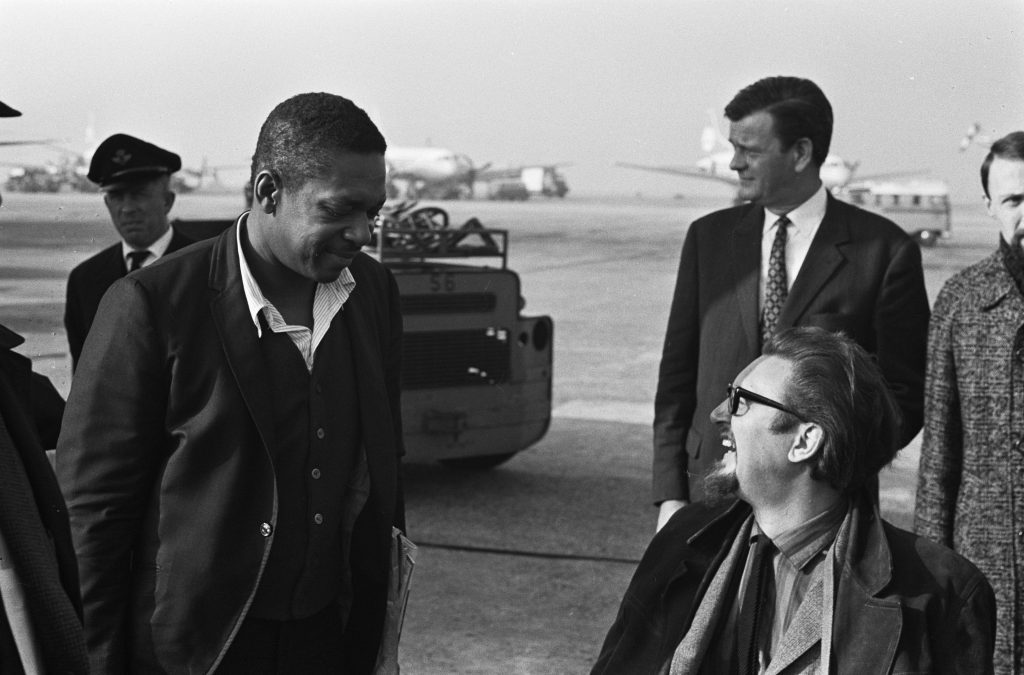
John Coltrane lost in thought
Jazz and Indian music’s long affinity is based on more than just improvisation. Despite their ‘free’ approach, musicians from both traditions are often obsessive and disciplined learners, who restlessly search to push their understandings forward. Musical competence brings cerebral demands – reharmonizing doesn’t come easy, and nor does balancing a rāga’s full form over odd-time tala cycles.
Disciplining your intuition is core to learning any improvised tradition, and Indo-jazz links go deep into the cultural and psychological – I’ll be investigating them in depth in an upcoming article. For now, here’s a rundown of some cross-genre highlights, along with some classical forms they point towards in shape, instrumentation, or mood.
First up, it’s important to remind ourselves that borrowing has always gone both ways – Indian musicians have been experimenting with jazz for almost a century. The Bombay jazz scene was flourishing before Miles Davis was even born, as locals jammed with African-American musicians who toured the world to escape racial discrimination back home.
Much of the resulting music went unrecorded, but some later artefacts capture an essence of it. Shankar-Jaikishan’s Rāga Jazz Style places filmi melodies on sitar, saxophone, flute, and piano, backed by hard-hitting Goan drummer Leslie Godinho (some say that Take Five was written after Joe Morello jammed with Godinho in a Delhi hotel room).
Fusions are rarely as simple as a Westerner journeying to far-flung lands to collaborate, or an Indian star learning jazz harmony later in life. The late composer John Mayer (no not that one) was born in Kolkata to Anglo-Indian parents, and studied classical music there before moving to London’s Royal Academy in 1952. His landmark Indo-Jazz Suite sees five Indian instrumentalists form a ‘double quintet’ with Jamaican-born Joe Harriott’s jazz group. Mishra Blues exemplifies this fine balancing act, with thudding basslines leaving sax and sitar free to roam.
Yusef Lateef brought African, Arabian, and Indian sounds into 60s hard bop. On Back Home he pairs harmonica with the rough screams of a shehnai, an oboe-like reed derived from ancient snake-charming instruments. Hear Bismillah Khan guide a group of four classical shehnai through Malkauns, said to have been composed by the goddess Parvati to soothe Lord Shiva’s rage.
John Coltrane’s Indian immersions continue to resonate through the jazz world. Like Hendrix, he was in awe of Ravi Shankar (“I’m certain that if I recorded with him I’d increase my possibilities tenfold”), even naming his son after him. On India he adds twisting chromaticism to a Vedic chant melody borrowed from Religious Music of India, a 1952 Smithsonian Folkways compilation. On live takes such as Afro Blue he upends the traditional delicacy of soprano sax with swooping inflections – he’d almost certainly been listening to shehnai recordings with Lateef, a close friend. Hear how Punjabi musicians use its power to call across the Surraki valley.
Like the ustads and pandits of India, Coltrane integrated the technical with the mystical and philosophical, dedicating himself to making his music an extension of his whole being. He would have been familiar with the Hindu concept of nada brahma (‘god as sound’), referring to the belief that all creation arose from an eternal cosmic vibration.
Compositions such as Africa and Olé use looping grooves to summon this feeling, as if revealing an unchanging sound that has always been there. He makes these influences explicit on later avant-garde works such as Om and Meditations, chanting from the Bhagavad Gita. Hear how the Gundecha Brothers bring their own sharp colours to ancient Shiva chants.
I wish Trane had lived to hear more of what he helped to set in motion – jazzers have since taken Indian ideas around the globe. His wife Alice collaborated with Pharaoh Sanders on Journey in Satchidananda, where harp and alto sax stir a heavy soup of tanpuras and circling bass motifs. Later, she brought a dreamlike approach to devotional chanting, recording privately with her ashram followers.
Kadri Gopalnath became entranced by the saxophone as a young child in Mysore, and spent the next 20 years taking it into Carnatic classical music, eventually being awarded the Sanskrit title ‘Saxophone Chakravarthy’ (‘benevolent ruler, whose wheels are moving’). American saxophonist Rudresh Mahanthappa goes in the other direction, exploring his Indian roots alongside jazz big band and bansuri flute on Ganesha. Gopalnath and Mahanthappa have collaborated, trading angular lines over rattling Carnatic drums (Kinsmen).
Englishman Jesse Bannister deviated from his jazz sax curriculum to focus on Hindustani music. He brings new colours to Bageshri with exacting dynamic control, and takes jazz far from its urban roots on Shivranjani, recorded solo in the complex acoustics of a Cumbrian cave. Kit virtuoso Buddy Rich recorded with tabla star Alla Rakha in 1968 (Rich A La Rakha), and modern Percussionist Sarathy Korwar draws on Afro-Indian folk, collaborating with Siddi musicians who migrated from Southern Africa centuries ago (Bismillah).
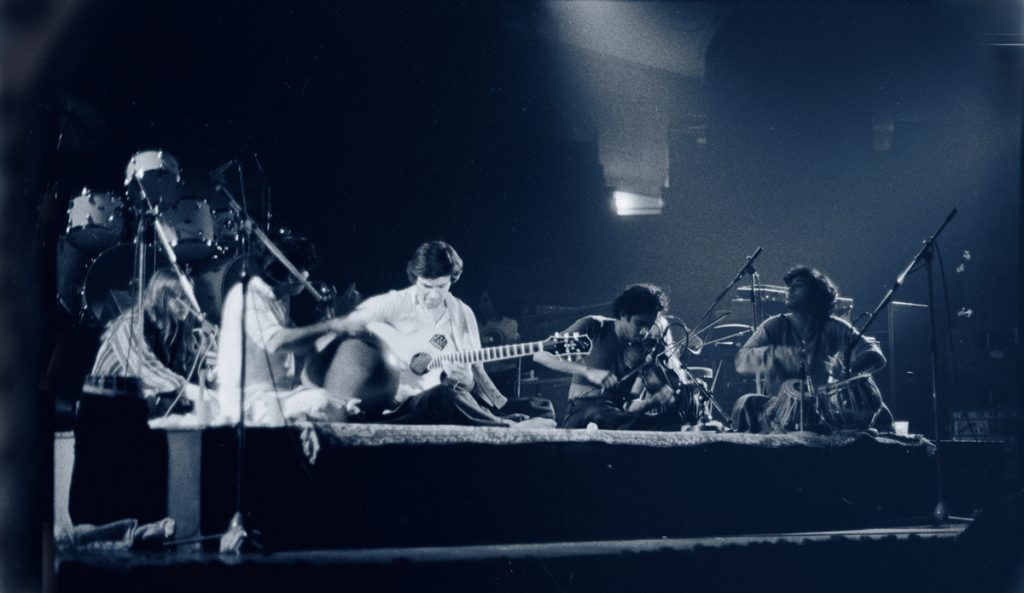
John McLaughlin leads Shakti
No Indo-jazz rundown could omit master fusioneer John McLaughlin. After leaving the Miles Davis group, his guitar style became imbued with Hindustani melodies and Carnatic konnakol rhythms. He went far in, learning the veena and studying with Ravi Shankar and vocalist S Ramanathan. Like Coltrane, his foremost idol, he aimed for a deep personal integration of the musical and spiritual, following superstar guru Sri Chinmoy for a time. In the Mahavishnu Orchestra he brings odd-time melodies to stadium crowds with extreme volume.
McLaughlin’s all-acoustic Shakti group united musicians from North and South India, featuring violin, tabla, and Carnatic percussion (mridangam, kanjira, and ghatam). He wields a modified guitar with sitar-like scalloped frets and sympathetic strings, opening up new sonorities. They drew direct inspiration from the greats, quoting sarod lines from Ali Akbar Khan’s mournful rendition of Sindhu Bhairavi on Isis.
We’ll go further into Shakti’s music in an upcoming article, but for now let’s listen to the musicians in their classical settings – L. Shankar’s violin, Zakir Hussain’s tabla, and the Vinayakram family’s kanjira tambourine, ghatam clay pot, and konnakol rhythm vocalisations. Remember Shakti, a later incarnation of the band, paired McLaughlin’s electric with various Indian stars, including Hariprasad Chaurasia’s bansuri flute, Shivkumar Sharma’s santoor, U Srinivas’ mandolin, and Shankar Mahadevan’s voice.
Modern Indo-jazz is a sprawling mass of unclassifiable interchanges. Westerners continue to explore, and India’s jazz scene flourishes in Mumbai, Goa, and beyond, with Amyt Datta’s menacing jazz guitar, Gino Banks playing neo soul, and Purbayan Chatterjee bringing fusion lines to the sitar. I’m glad to feel this article may soon seem out of date.
Hip-hop
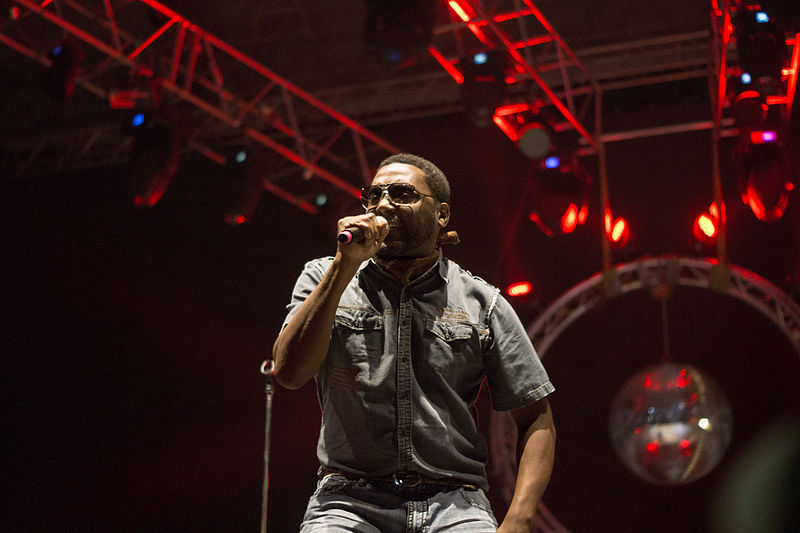
Big Daddy Kane gets physical, mystical, very artistical…
Let’s lay down a challenge – how many rappers could match Yogesh Samsi’s vocal flow? Big Daddy Kane may claim to be second to none (“making MCs run…”), but could he control syllables like Yogesh does as he recites the bol strokes of tabla compositions? I’ll leave this as an open question, but imagine Big Daddy would admire the famed dedication of Indian musicians (“I work like a slave to become a master…”).
Hip-hop and Hindustani are an instant match in other ways too. Both styles are usually performed as duets – MC & DJ, sitar & tabla – and build themselves around loops. Lehra are short repeated melodies which serve to anchor the syncopation of tabla solos, and hip-hop’s looped samples play a similar role, allowing MCs to deviate far from standard rhythmic phrasings without losing the groove.
Hear Zakir Hussain recite some bol compositions over a lehra, and then play them on the tabla. The cycling melody helps you keep time, allowing Zakir’s angular flows to wander to and from the underlying groove. Or for instrumental hip-hop heads, listen to Kumar Bose’s tintal tabla bring the noise to a floating sarangi line.
Indian ideas have even found indirect pathways to influencing hip-hop innovators. Rakim played the sax, and recounts improving his vocal flow by rhythmically matching it to John Coltrane solos. Who knows what Paid in Full would have sounded like without Coltrane’s study of Indian forms? But more to the point, has a bol or konnakol master ever gone along to an open mic to spit some bars?
House & techno
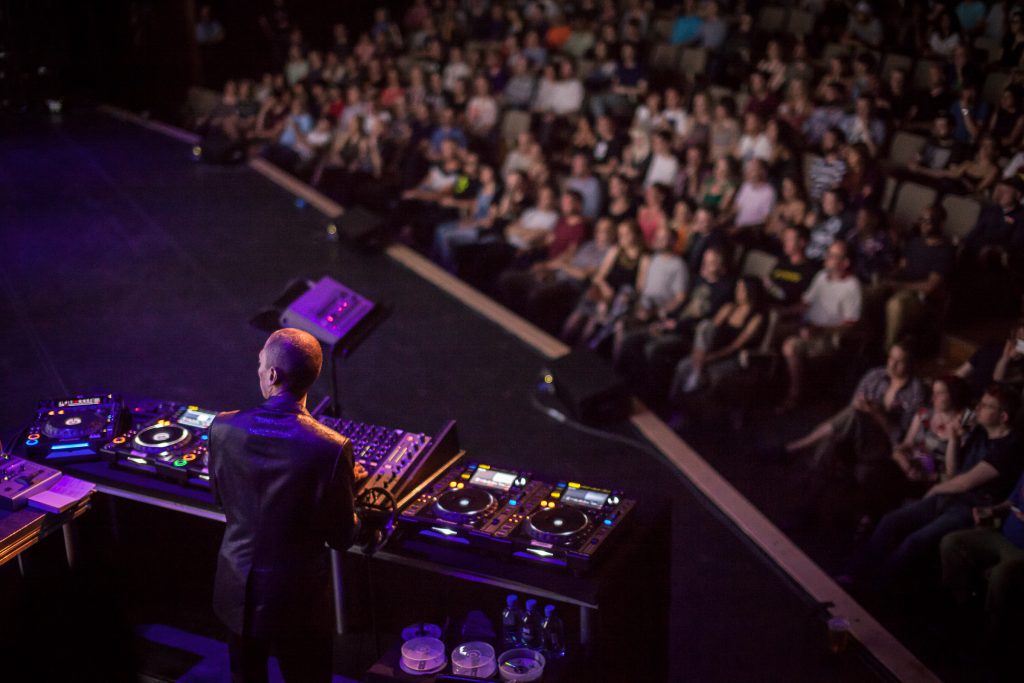
Jeff Mills commands the Southbank Centre (Photo: Victor Frankowski)
The best house and techno sets are masterworks of gradual development. DJs carefully select and order tracks on the fly, responding to the mood of the crowd to form a coherent whole. Heavy rhythms loop and fade into each other until the early hours, bringing moments of release, space, and surprise. Like Indian music, house and techno demand patience and precision.
So if you’re partial to Jeff Mills or Carl Cox then you may find similar delights in long-form rāgas. Hear how Shahid Parvez’ sitar slowly elaborates each note of Darbari, uncovering melodies and spiralling through dense rhythms, all building to a cascading final release almost an hour later. Classical tabla soloists patiently run composed patterns through the kayda system’s mathematical permutations, with Kishan Maharaj’s devotional solos commanding a firm reverence.
Ever been enthralled by the timing of a kick drum line? Try out Gurdain Rayatt’s fierce jori playing, and see how he controls the bass space with deep resonating tones, from 120bpm upwards. And hear Rahul Sharma’s santoor circle around Kalavati, climbing up the scale and then releasing tension every 4th bar – an idea familiar to any techno head.
And why not be hypnotised by rhythms other than 4/4? Let Alla Rakha be your guide through jhaptal’s 10-beat cycle on Jogeshwari (a track sampled by Four Tet). A pair of tabla can command the stage just as well as a pair of turntables – come and see it live (Darbar Festival is easier to get into than Berghain).
Jungle, DnB
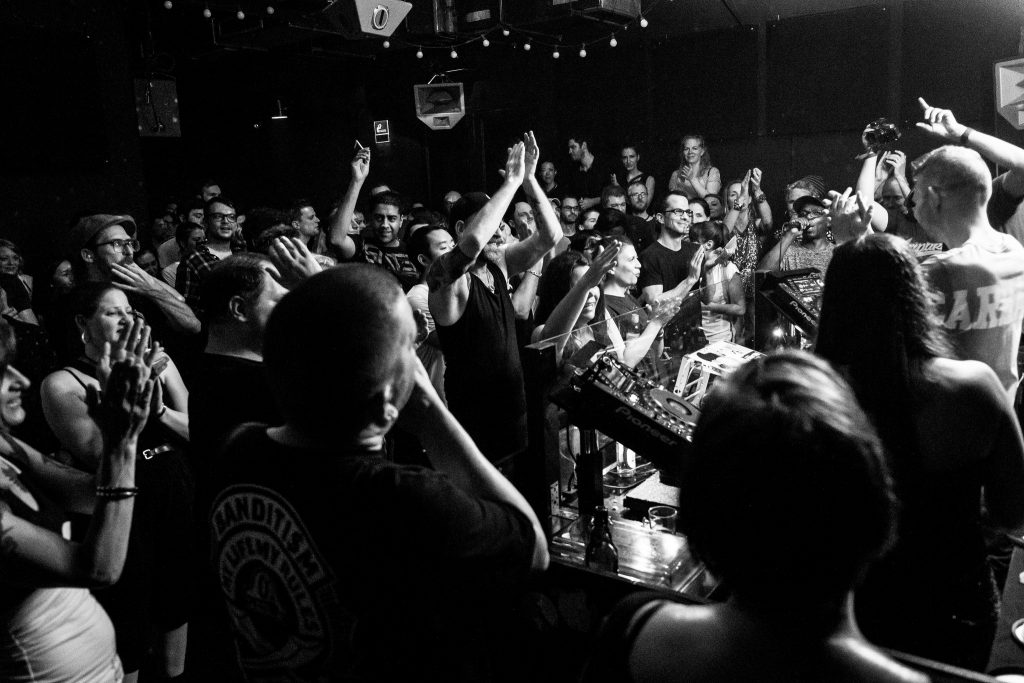
DJ Storm unleashes heavy drops (Photo: Martin Krolikowski)
Oldskool jungle has some seriously striking similarities with tintal tabla solos: ambient backdrops, rapid 16-beat loops, and intense bursts of syncopated rhythm replacing melody as the central ‘voice’. The textures used aren’t so different either – busy percussion, floating harmonic colour, and almost-melodic superdeep bass Turn up Zakir Hussain & Alla Rakha’s Lineage tabla duet, and wait for the drop.
Ragga jungle MCing serves a somewhat similar function to Indian rhythm languages such as bol and konnakol, with vocalisations serving to define rhythmic flow rather than lyrical meaning. MC Demolition Man might like Lachu Maharaj’s ceremonial chilla preparations as well as his energetic tabla solos. Maharaj brings a playful touch to jagged drops, with deep Reese-style bass tones and rhythmic complexity that baffles more and more as you zoom in (trust me…).
Direct fusions have also hit fertile ground, with Talvin Singh’s tabla breaking ground for Britain’s Asian Underground scene, and Bill Laswell teaming up with Zakir Hussain to make sonically dense jazz-jungle in Method of Defiance. It doesn’t stop there – I’ve written a full article on this for fellow junglists. (Nowadays you can even find unknown bedroom musicians releasing rāga-jazz-jungle fusions on the far-flung corners of YouTube…).
Western Classical

Matthew Barley’s Universal Notes at Darbar 2016
Like the finest rāgas, Bach’s solo violin and cello works are masterpieces of single-line melodic development. Western string works are played ‘straight’, with performers sticking to the score and intoning rigidly. Carnatic violin takes a radically different approach, improvising heavily and sliding around the fretboard to blur a melody’s boundaries.
Listen to L. Shankar’s soaring solo on Shakti’s La Danse De Bonheur, overflowing with fluid articulations and running through the high register with reckless abandon (every violinist I’ve played this to has been left speechless). Shankar later developed the 10-string double-neck electric violin, and uses it to borrow Western cadences on Rāgam-Tanam-Pallavi.
Bach, Beethoven, and Liszt were all renowned ad-libbers, but modern students are often denied opportunities to improvise. Fitting extended improv into tightly composed music adds further challenge, but some Indo-Western classical collaborations have hit the mark. Yehudi Menuhin’s duets with Ravi Shankar paved the way for their students Daniel Hope and Gaurav Mazumdar, who brought more freedom to similar tradeoffs a generation later.
Zakir Hussain’s refreshing Tabla Concerto places captivating rhythms centre stage, and Carnatic violinist L Subramaniam’s Double Concerto brings a thick timbre to limber themes. Indian-born maestro Zubin Mehta has arranged Kashmiri folk songs for the orchestra (Rind Posh Maal), and conducted the Berlin Philharmonic for Ravi Shankar’s Sitar Concerto.
Eric Whitacre has a sitar introducing slow choral harmonies (Winter), while David Murphy surrounds Amjad Ali Khan’s sarod with the Scottish Chamber Orchestra’s gently undulating embrace (Bhairavi). Philip Glass takes a different approach on Passages, sharply tethering Shankar’s sitar with punctuating ostinatos. Lubomyr Melnyk’s continuous piano draws on the disciplined stamina of rāga lines, and Matthew Barley’s year-long Indian collaboration for Darbar culminated in Universal Notes, a superb ensemble work which blends sophisticated string writing with strident melodic improvisation.
There is plenty of unexplored territory here. Bach’s sarabandes use a Berber dance rhythm from North Africa – could they be translated to the tala cycles? Someone should ask Dutch cellist Saskia Rao-de Haas (Bhimpalasi), or Carnatic violinists V.S. Narasimhan (Bach Meets India) and Ilayaraja (I Met Bach at my House).
Would Beethoven’s violin sonatas work as a basis for Ganesh & Kumaresh’s improvised duets? And how might Ravel’s glistening note clusters be recoloured by the fluid piano, which adds sliders to the strings? Hear Utsav Lal unlock the ‘spaces between the notes’ in Bageshri. Perhaps more avenues like this will be explored soon – innovative British label Zeroclassikal seeks to take South Asian classical music to new spaces, commissioning new works each year.
Ambient, Drone, Minimalism
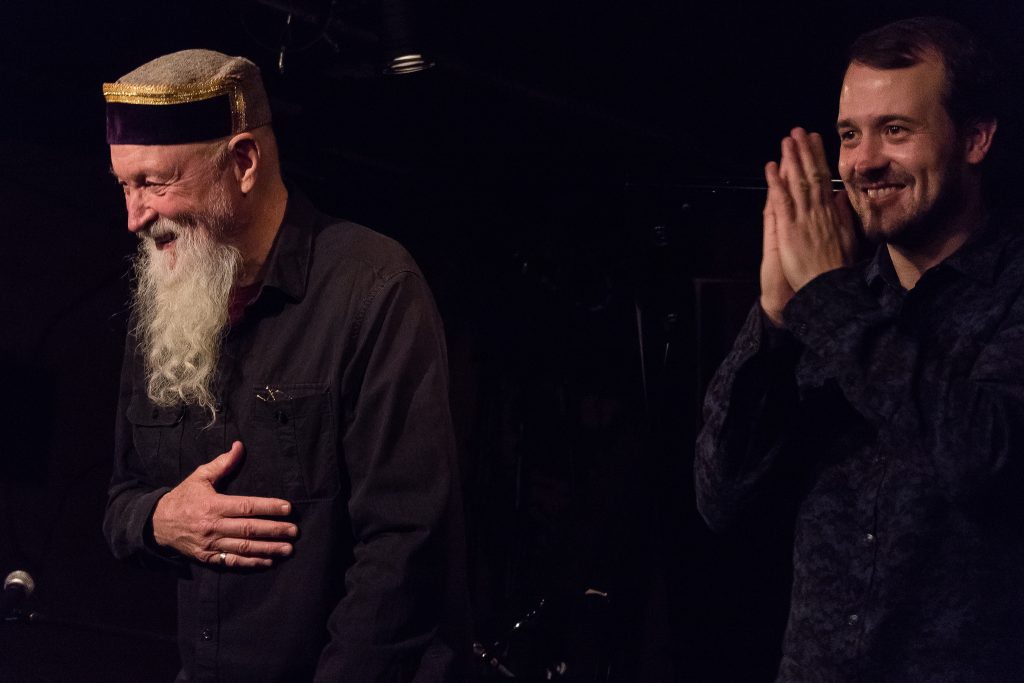
Terry & Gyan Riley in Tokyo (Photo: Martin Krolikowski)
Ambient can trace a direct lineage back to the slow textures of Dhrupad singing, one of India’s oldest musical traditions. Modern ambient heavyweights like Stars of the Lid and William Basinski all draw on Brian Eno’s late 70s work, and Eno was in turn enthralled by La Monte Young, an unclassifiable giant of the avant garde.
Young studied under Pran Nath for 26 years, a Dhrupad singer from the Kirana gharana. The influence cannot be overstated – Young staged all-night rāga cycles in New York, and released hour-long albums featuring nothing but finely-tuned tanpuras. Many of his seminal works are built around a droning meditational core, with alien saxophone lines drawing you into the ‘outside of time’ feeling of nada brahma (Bb Dorian Blues). Nath himself spent a lifetime exploring the sparsely mournful Malkauns, often reminding followers that “the rāga is created in between the tones”.
Young’s focus inspired others around him, with Eno sampling sitars on 1977’s One. Jazzers Lee Konitz and Don Cherry also studied with Nath, as did minimalist icon Terry Riley. Intriguing footage exists of Riley and Nath visiting Tapkeshwar caves together, where the latter lived in seclusion for years, imitating birdsong and substituting a tanpura for the sound of running streams. Riley’s synth masterpieces owe a clear debt to sruti (Indian microtonality) – listen to the Gundecha Brothers use it subtly on Charukeshi. Today sound artist Antti Tolvi explores direct Indo-ambient links of his own, having studied in Varanasi.
Steve Reich famously drew from Ghanaian polyrhythm, but his ‘systems music’ philosophy shares common conceptual ground with India. Reich typically avoids exacting scores, instead notating musical ‘ingredients’ for the musicians and directions on how to blend them – Drumming and Music for 18 Musicians do not have set section lengths.
Rāgas work on similar lines – they are melodic ‘mood recipes’, with characteristic phrases and detailed guidance on emphasis, transformation, and development. rāga performances churn these ingredients through several different rhythm cycles, transitioning on the fly. Hear Rahul Sharma guide Kalavati’s invocation of the goddess Parvati, driven forward by a dual tabla and pakhawaj percussion section.
Odds & ends
The examples above barely scratch the surface. Hindustani and flamenco were both profoundly coloured by Islamic influences, and have been reunited by Anoushka Shankar (Traveller). Leftfield disco innovator Charanjit Singh matched rāga scales with synthesisers and pounding drum samples (Ten Rāgas to a Disco Beat). American ‘Primitivist’ folk guitar often incorporated Indian themes, exemplified by Robbie Basho’s North American Rāga. And Missy Elliott brought tabla and tumbi into Hollywood clubs with Get Your Freak On. I could go on, but you get the idea.
Comparing Indian styles to seemingly distant genres will deepen your connection to both, and illuminate some fundamental truths about how we perceive music. It also brings the radical effects of cultural unfamiliarity into clear focus. Mainly, it’s a dependably fascinating way of expanding your appreciation for music in all its forms. How do you really know what you like without exploring? (On that note – please let me know what I’ve missed!)
——————
Darbar Arts & Heritage believes in the power of Indian classical music to stir, thrill, and inspire. To find out more, sign up for the Darbar newsletter or explore their YouTube channel.
George Howlett | www.ragajunglism.org

